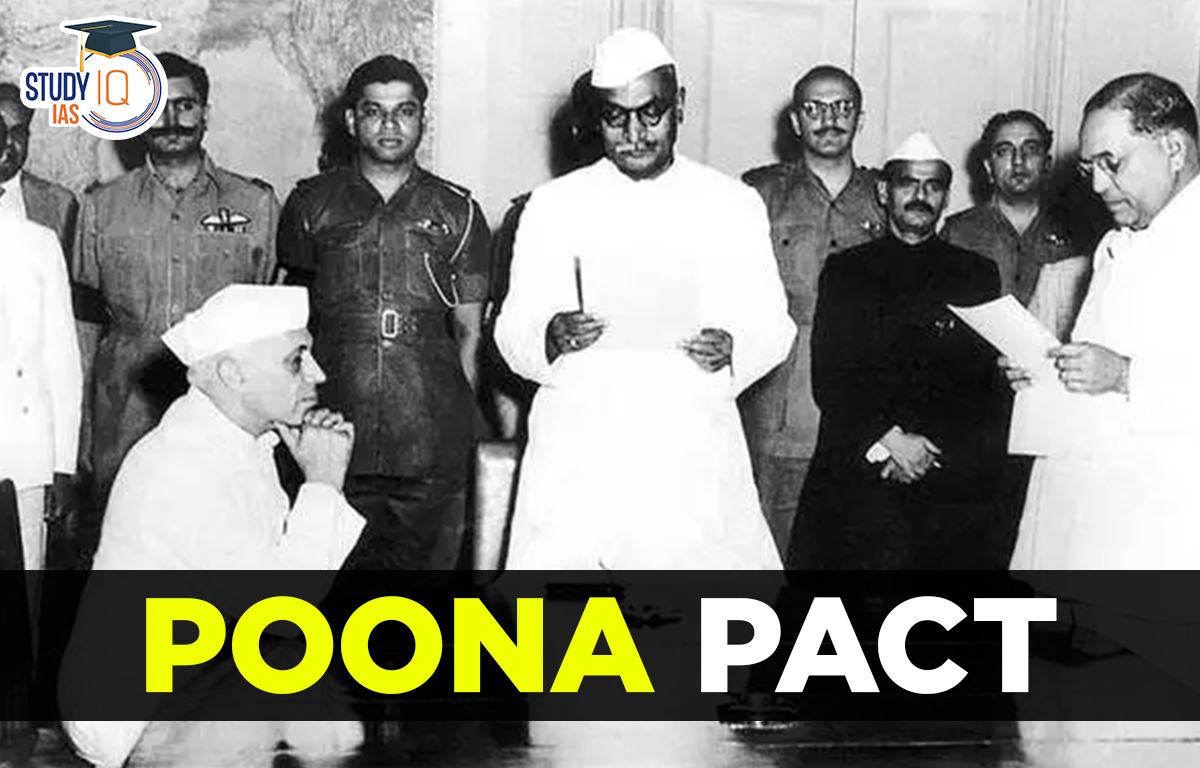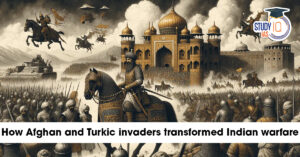Table of Contents
Poona Pact
Poona Pact was signed by Dr. Babasaheb Ambedkar and Mahatma Gandhi on September 24, 1932, in the Yerwada Central Jail in Pune. The administration emphasizes the agreement as a modification to the Communal Award.
The pact is a result of the fusion of two diametrically opposed ideas (Gandhi’s Social Approach and Ambedkar’s Political Approach), with the aim of attaining a shared objective for the upliftment of one of India’s most vulnerable groups of society. This post will describe the Poona Pact, which is useful for preparing for the UPSC examination.
Read about: Gandhi Irwin Pact
Poona Pact History
The Communal Award, which established separate electorates for the Depressed Classes, Europeans, Sikhs, Anglo-Indians, and Indian-based Christians, was announced by British Prime Minister Ramsay MacDonald on August 16, 1932. The principle of separate electorates, which the British government had already adopted through the Morley-Minto Reforms (1909) and the Montagu-Chelmsford Reforms (1919), served as the foundation for the 1932 Award.
Only members of these communities were entitled to vote to elect a representative to legislative assembly, and each community was given a set number of seats in the legislature under a separate electorates system. The communal prize was fiercely opposed by Mahatma Gandhi, who saw it as a component of British imperialists’ continual efforts to split Indians into a number of specialised factions and weaken the national movement.
Ambedkar initially backed the prize because he thought that political measures like a separate electorate would help bring up the oppressed sections. But after several rounds of negotiations, Gandhiji and Ambedkar came to an agreement known as the Poona Pact, which led to the elimination of a distinct electorate for the oppressed classes.
Poona Pact Provisions
Dr. Ambedkar agreed with the idea of a distinct electorate for the disadvantaged group. At the inaugural Round Table Conference, where he attended as the Dalit delegate, he expressed his support for a distinct electorate. Mahatma Gandhi, on the other hand, was vehemently opposed to the concept of a separate electorate. He continued fasting in the Yerwada jail in Poona to express his opposition to the idea put out by Prime Minister Ramsay McDonald.
The Poona Pact, which Dr. Bhimrao Ambedkar and Gandhi signed in response to public demand to end the fast to death, established reserved seats in the provincial legislature for the underprivileged classes, with elections held using merged electorates. Gandhi disagreed with this idea because he didn’t want untouchables to be viewed as outside the purview of Hinduism.
The provincial legislature would reserve a few seats for the underprivileged. The total number of provincial councils was used to calculate the number of seats. Thirty seats were given to Madras, eight to Punjab, fourteen to Bombay and Sindh, twenty to the Central Provinces, eighteen to Bihar and Orissa, forty-six to Bengal, seven to Assam, and twenty to the United Provinces. Consequently, there were 147 reserved seats in all.
For each of these seats, there would be an electoral college made up of qualified members of underprivileged classes. A group of depressed classes may be chosen by these electoral classes. One vote would be required to elect these candidates. Election of the four candidates with the most votes.
These people cast two votes since they were eligible to vote under both the general electorate and the backward classes. The central legislature intended to use the same strategy of a combined electorate and reserved seats. Members of the underprivileged classes would receive 19% of the seeds in the central legislature.
This arrangement will continue for 10 years unless both parties decide to terminate it sooner. Fair representation of the oppressed classes would be guaranteed through all available measures. Nobody would be subjected to cast-based discrimination whether seeking for a position in local government or being hired by the government. The educational grant in each province would provide a specified amount to help with the education of people from lower socioeconomic classes.
Read about: Lucknow Pact
Poona Pact Significance
As part of a deal he reached with Mahatma Gandhi, Bhimrao Ambedkar agreed to have candidates from the underprivileged class chosen by a joint electorate. In addition, 147 legislative seats—nearly twice as many as the community award—were reserved for the oppressed classes.
The Poona Pact also guaranteed that underprivileged groups received fair representation in public services while providing a portion of subsidies for their education to continue their advancement. Higher-class Hindus publicly acknowledged with the Poona Pact that the underprivileged class was the most unfairly treated group in India.
Additionally, it was decided that quick, severe action was required to help politically the underprivileged segment of society. The treaty made the entire country ethically answerable for the moral uplift of the lower classes.
The concessions made under the Poona pact formed the basis of the greatest affirmative action program in history, which was eventually put into force in independent India and included reservations for jobs in the public sector, the government, and educational institutions. Above all, the alliance was the first in India’s history to transform the oppressed classes into a potent political force.
Poona Pact Impact on Dalits
Since independence, Dalits have been seen as the most disadvantaged and impacted group in society. The Poona Pact gave them political rights, but once it went into effect, it was a failure. The Poona Pact made an effort to free the oppressed classes, but it was unsuccessful despite granting them political rights.
It consequently led to a lot of problems while allowing the previous Hindu social order to endure. Actually, as a result of this agreement, the disadvantaged group became political puppets that Hindu caste organizations could use to their benefit. Genuine class representatives were unable to confront the stooges chosen and supported by Hindu caste groupings, leaving the depressed class without a leader.
The result was that the underprivileged classes were prevented from establishing an independent and true leadership to oppose the Brahmanical system and were forced to accept the status quo in the fields of politics, philosophies, and cultures. So it is possible to say that the Poona Pact stopped the development of the kind of society that valued equality, liberty, justice, and fraternity.
It disregarded the rights and safeguards guaranteed to people in the independent India’s constitution by refusing to recognizing the Dalits as a separate segment of the population.
Poona Pact Impact on Depressed Classes
The Poona Accord allowed caste-based Hindu organizations to use the oppressed group as political pawns. The depressed classes were left without a leader since the true class representatives were helpless to stop the stooges chosen and supported by caste Hindu organizations. The Poona Pact’s primary objective was to provide the poor more seats in exchange for their agreement to the ongoing existence of a united electorate.
An electoral college made up of all operated class members who were registered to vote in a constituency was known as a combined electorate, and it was used to elect a panel for four candidates from the oppressed classes to the reserved seat. The single-vote method was used for this election.
For each of the reserved seats, the general electorate would select the top four candidates from the primary election. A percentage of the seats granted to the larger non-Muslim voter base would be distributed to the underprivileged class. According to congressional approval, the oppressed classes would receive enough representation in the Civil Services. As a result, those from the lower classes decided to support the concept of a shared electorate.
In the provincial legislatures, seats were reserved for the underclass from the regular Muslim seats. The number of seats was 36 in Madras, 30 in Bengal, 7 in Assam, 20 in the United Provinces, 20 in the Central Provinces, 18 in Bihar and Orissa, 15 in Bombay, and Sindh, and 8 in Punjab.
The shared electorate system prevents scheduled caste from electing genuine and effective representatives to legislatures, and the most recent elections were held in accordance with the Government of India 1935 Act, according to the working committee of the All India Scheduled Caste Federation.
Poona Pact Limitations
The Pact turned the lower classes into political pawns that the Hindu organization’s majority caste could employ. Even now, the depressed classes continue to come together for political gain and become a vote bank. Additionally, it prevented the depressed classes from developing autonomous and authentic leadership to challenge the Brahminical order, forcing them to accept the existing quo in political, intellectual, and cultural spheres.
By depriving them of a separate and distinct existence, it forced the lower classes to become a part of the Hindu social structure. The system of joint electorates, according to the Working Committee of the All India Scheduled Caste Federation, denied the scheduled castes the ability to send true and effective representatives to the legislatures during the most recent elections held in accordance with the Government of India Act, 1935.
The committee went on to say that the combined electorate’s provisions effectively granted the Hindu majority the power to designate members of the scheduled castes who were willing to serve as their tools. As a result, even after signing the Poona Pact, Dr. B.R. Ambedkar kept criticizing it till 1947.
Poona Pact UPSC
The Pact was a turning point in India’s political and constitutional history. The freedom movement and talks between Indians and the British were forever marred by tensions between the Hindus and the Depressed Classes that were brought to light by this. The Pact substantially strengthened and expanded the argument that the Depressed Classes constituted a political minority whose interests could not be disregarded while creating India’s future constitution. This article contains comprehensive information about the Poona Pact for the UPSC/IAS Examination.
Poona Pact FAQs
Q) What was the Poona Pact Why?
Ans. On September 24, 1932, M K Gandhi and B R Ambedkar signed the Poona Pact in the Yerwada Central Jail in Poona on behalf of the oppressed class, calling for the reservation of seats in the legislature for them.
Q) What was Poona Pact agreement?
Ans. Dalits, low-caste Hindu groups who were then frequently referred to as “untouchables,” received additional privileges via the Poona Pact, an agreement amongst Hindu leaders in India on September 24, 1932.
Q) Who signed on Poona Pact?
Ans. The Poona Pact was signed by Mahatma Gandhi and Dr Ambedkar on September 24, 1932.
Q) What were the main features of Poona Pact?
Ans. The Poona Pact provided reserved seats in the national and provincial legislative councils for members of the lower classes. The general electorate was expected to vote on them.
Q) Who launched Poona Pact?
Ans. The Poona Pact was an agreement made in 1932 between Mahatma Gandhi and Dr. B. R. Ambedkar on behalf of Dalits, the underprivileged classes, and higher caste Hindu leaders on the allocation of seats in the legislature of British India to the underprivileged classes.
Major Incidents in Indian History
- Quit India Movement
- Chauri Chaura Incident
- Jallianwala Bagh Massacre
- Green Revolution in India
- Non-Cooperation Movement
Famous Personalities Biography
Mangal Pandey |
Maharana Pratap |
Rabindranath Tagore |
Bhagat Singh |
Jyotiba Phule |
Satyendra Nath Bose |
Raja Ram Mohan Roy |
Subhash Chandra Bose |


 Birsa Munda Birth Anniversary 2025: Life...
Birsa Munda Birth Anniversary 2025: Life...
 Military Innovations of Afghans and Turk...
Military Innovations of Afghans and Turk...
 Self-Respect Movement, History, Objectiv...
Self-Respect Movement, History, Objectiv...

























